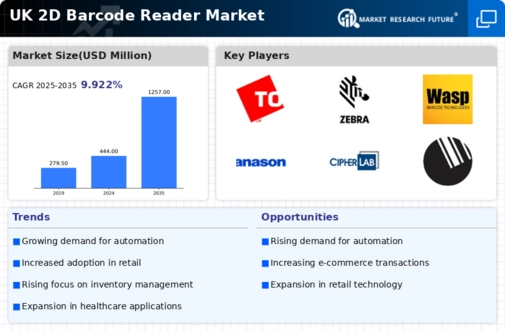Rising E-commerce Adoption
The surge in e-commerce activities in the UK has propelled the demand for efficient inventory management solutions, thereby driving the 2d barcode-reader market. As online shopping continues to gain traction, retailers are increasingly adopting 2d barcode readers to streamline their operations. This technology facilitates quick scanning of products, enhancing the customer experience and reducing checkout times. According to recent data, the UK e-commerce sector is projected to grow by approximately 14% annually, which correlates with the rising need for advanced scanning solutions. Consequently, businesses are investing in 2d barcode readers to manage their inventory effectively, ensuring accuracy and efficiency in order fulfillment. This trend indicates a robust growth trajectory for the 2d barcode-reader market, as companies seek to optimize their supply chains and improve operational efficiency.
Increased Focus on Supply Chain Efficiency
The emphasis on optimizing supply chain processes is significantly influencing the 2d barcode-reader market. Companies in the UK are increasingly recognizing the importance of real-time data tracking and inventory management to enhance operational efficiency. 2d barcode readers play a crucial role in this context, enabling businesses to monitor stock levels, track shipments, and reduce errors in order processing. As organizations strive to minimize costs and improve service delivery, the adoption of 2d barcode readers is expected to rise. Recent statistics indicate that businesses implementing barcode scanning solutions can achieve up to a 30% reduction in inventory discrepancies. This focus on supply chain efficiency is likely to propel the growth of the 2d barcode-reader market, as firms seek to leverage technology for competitive advantage.
Growing Demand for Contactless Payment Solutions
The increasing preference for contactless payment methods is emerging as a significant driver for the 2d barcode-reader market. In the UK, consumers are gravitating towards payment solutions that offer convenience and speed, particularly in retail environments. 2d barcode readers facilitate contactless transactions by enabling quick scanning of QR codes, thereby enhancing the customer experience. As businesses adapt to this shift in consumer behavior, the demand for 2d barcode readers is expected to rise. Market analysis indicates that the contactless payment segment is projected to grow by approximately 20% annually, which could substantially impact the 2d barcode-reader market. This trend underscores the necessity for retailers to invest in advanced scanning technologies to meet evolving consumer preferences and maintain competitiveness.
Technological Advancements in Scanning Solutions
The continuous evolution of scanning technologies is a pivotal driver for the 2d barcode-reader market. Innovations such as enhanced imaging capabilities and improved connectivity options are making 2d barcode readers more efficient and user-friendly. The integration of artificial intelligence and machine learning into scanning devices is also enhancing their functionality, allowing for faster and more accurate data capture. As businesses in the UK seek to leverage these advancements, the demand for sophisticated 2d barcode readers is likely to increase. Market data suggests that the adoption of advanced scanning solutions could lead to a growth rate of around 10% in the 2d barcode-reader market over the next few years. This technological progression not only improves operational efficiency but also positions businesses to better meet consumer expectations in a rapidly changing retail landscape.
Regulatory Compliance and Traceability Requirements
The increasing regulatory landscape in the UK is driving the need for enhanced traceability in various sectors, thereby impacting the 2d barcode-reader market. Industries such as food and pharmaceuticals are subject to stringent regulations that necessitate accurate tracking of products throughout the supply chain. 2d barcode readers provide an effective solution for ensuring compliance with these regulations by enabling precise data capture and record-keeping. As businesses strive to meet legal requirements and enhance product traceability, the adoption of 2d barcode readers is likely to increase. Recent data suggests that companies investing in traceability solutions can improve their compliance rates by up to 25%. This regulatory pressure is expected to bolster the growth of the 2d barcode-reader market, as organizations seek to implement reliable tracking systems.






















Leave a Comment